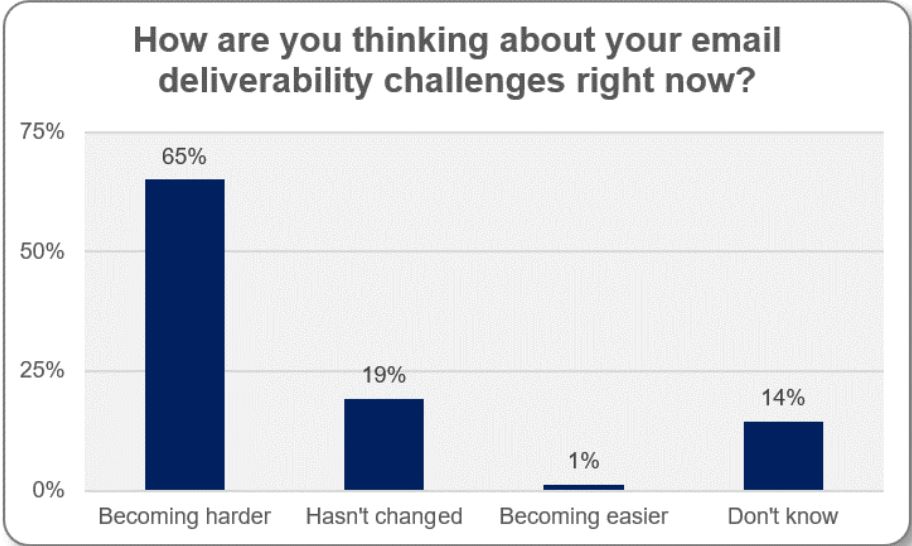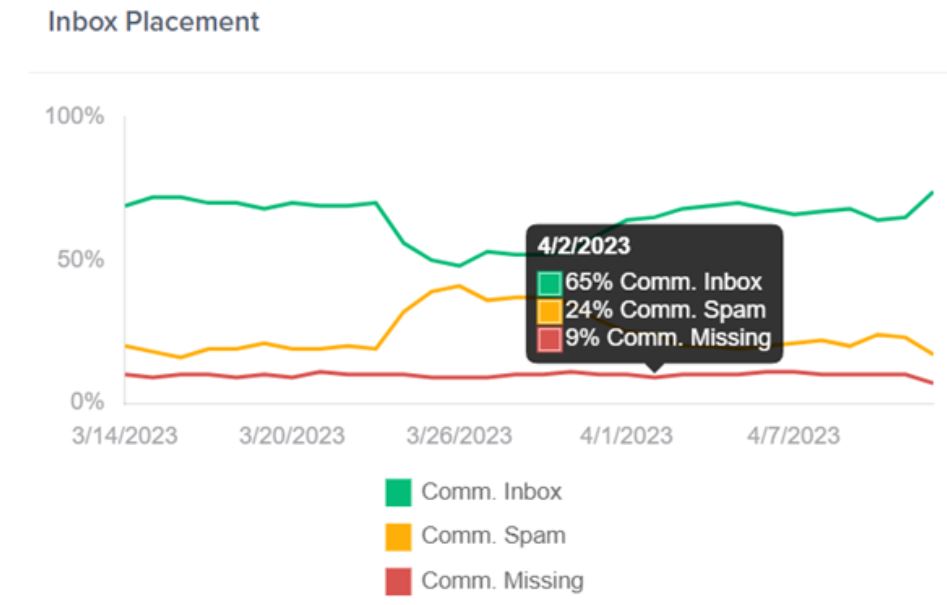
The average inbox placement rate (IPR) for email marketing programs around the world is 84.8 percent. This means one in every six legitimate, permission-based messages fails to reach the inbox. Instead, these messages end up in the spam folder (or blocked entirely), never to be seen or engaged with.
Email marketing is rightly celebrated for its great ROI (38:1). Marketing emails generate an average $0.10 in revenue, starkly illustrating the opportunity cost of poor deliverability. Every 1M emails placing at 84.8 percent means $15K less in sales revenue, which is pretty eye-watering!
We’ve quoted the one in six failure rate for several years now, which made us scratch our heads a bit. With our great deliverability solutions and world-class advice and thought leadership, surely senders should be getting better, right? Let’s dive into “why” behind the deliverability dilemma.
Top 3 reasons deliverability is getting harder
Seth Charles, Director of Deliverability and Compliance at Iterable, hits the nail on the head by likening the deliverability challenge to running a race where the finish line keeps shifting away! Deliverability is a constantly moving target, and a whopping 65 percent of our State of Email audience agrees that it is indeed becoming harder:
Why? There are several reasons:
1. Volume
Covid-19 represented a massive change for email marketing. Worldwide lockdowns meant email became the channel of choice for brands to communicate with their customers. Global volumes increased significantly, and then remained at these higher levels as the channel’s effectiveness was reinforced.
While this was good news for email marketers, filtering, blocking, and throttling by mailbox providers (MBPs) has increased as a response to the increased demands on bandwidth and processing capacity. The huge increase in Spamhaus’ informational listings highlights an increase in poor sending practices these MBPs are responding to.
Greater inbox congestion also means increased competition for eye share and reduced subscriber engagement.
2. Privacy
The introduction of vendor-driven initiatives like Apple’s Mail Privacy Protection (MPP) makes good deliverability harder to achieve. MPP causes open tracking pixels to fire automatically when emails are delivered to Apple Mail users, whether those emails were actually opened or not. These deprecated open rates have reduced the ability to measure true engagement, and IPRs at Apple have dropped to nearly 20 percent below the global benchmark.
While this data is specific to domains hosted by Apple (e.g., @icloud.com, @me.com or @mac.com) the effect extends to Gmail, Outlook, and Yahoo emails that are read using Apple Mail (approximately 40 percent of all marketing emails).
Steve Lunniss, Head of Deliverability at Cordial, remarks how many CRM teams have now moved to using overall engagement scores to build higher-performing audiences.
3. Recession
Subscriber engagement is a key part of good deliverability. However, since many subscribers have less disposable income than they used to, consumers are less likely to engage with emails promoting offers they can’t afford. This also causes increased deleted unread activity and more spam complaints, which are important data points used by MBPs to make filtering decisions.
What senders should do in response
1. Read mailbox provider guidelines
Email addresses hosted by the so-called MAGY grouping of MBPs (i.e., Microsoft, AOL, Gmail, and Yahoo) form five-sixths of a typical program’s list. Senders can apply a homogenous approach to the best practices they use because most are common across all the MAGY members.
You can learn more about MBP guidelines by reading any of the following resources:
2. Offset send times
Seventy percent of global email volume is sent during the first 10 minutes of each hour! This is because bulk sends are usually scheduled at the top of the hour. This places stress on delivery infrastructure, meaning more throttling, filtering, and blocking. It also means more emails are competing for subscribers’ attention when they arrive. Offsetting send times will have real benefits for both deliverability and engagement.
3. Remember the 50:50 active/inactive rule
Steve Henderson, Head of Deliverability at Emarsys, uses a simple rule of thumb: It starts with defining active subscribers as those who have shown signs of life within the past 90 days. Senders should then restrict the average volume they send to inactives to no more than 50 percent of their monthly total. Steve says deliverability gets much simpler when this ratio is maintained.
4. Make a virtue of MPP
Senders should stop thinking of Apple’s auto-generated pixel fires as proof of opens and more as proof of delivery. An MPP “open” confirms the target email addresses exist, and that messages haven’t gone to junk.
This data can also be used for trend analysis. For example, a sudden drop in proxy opens will likely indicate a deliverability problem.
5. Provide opt-out transparency
Complaints are the single biggest factor to depreciate sender reputation and deliverability. A key reason subscribers complain is to stop receiving emails.
DMA research shows only 25 percent of respondents think it’s easier to opt out using a native link than to mark the email as spam, mostly because those links are buried in email footers! Senders should adopt McDonalds’ best practice and keep their complaints low by transparently positioning their unsubscribe link in the email header.
Beat the deliverability blues with Sender Certification
So, how are other companies surviving the deliverability dilemma?
If you browse through Validity’s customer stories, you’ll find an amazing cross-section of world-famous brands like Virgin Atlantic, Philips, and Lastminute.com that have overcome their respective deliverability challenges and seen impressive upticks in IPR.
The common thread? They’re all members of Validity’s Sender Certified program.
MBPs around the world use Sender Certification as a positive signal when they make filtering decisions. Certified customers enjoy average IPRs of 99.2 percent (almost 15 percent higher than the global benchmark!) and, per our earlier calculation, an additional $15K per million emails sent!
Learn more about Sender Certification here.
How does your email program measure up?
As you can see, deliverability is only getting harder—and this trend will continue for the foreseeable future. The question is: Does your email program have what it takes to survive (and thrive) during these difficult times?
Validity’s 2023 Email Deliverability Benchmark report offers a wealth of insights into this important topic. To find out how your email program measures up when compared to many others around the world—and uncover the insider tips and tricks you need to beat the deliverability dilemma and take your email marketing to the next level—download your free copy today.


